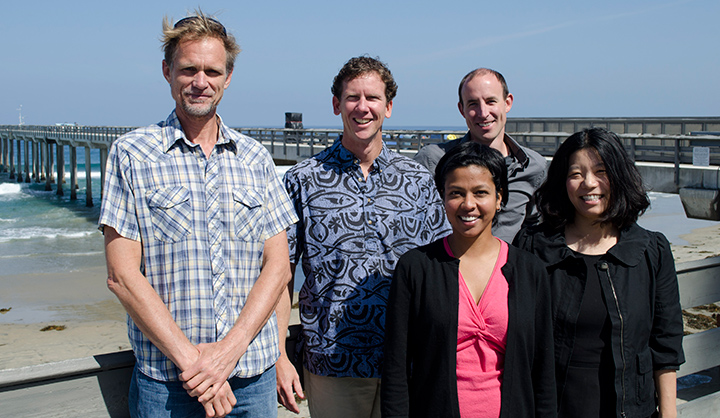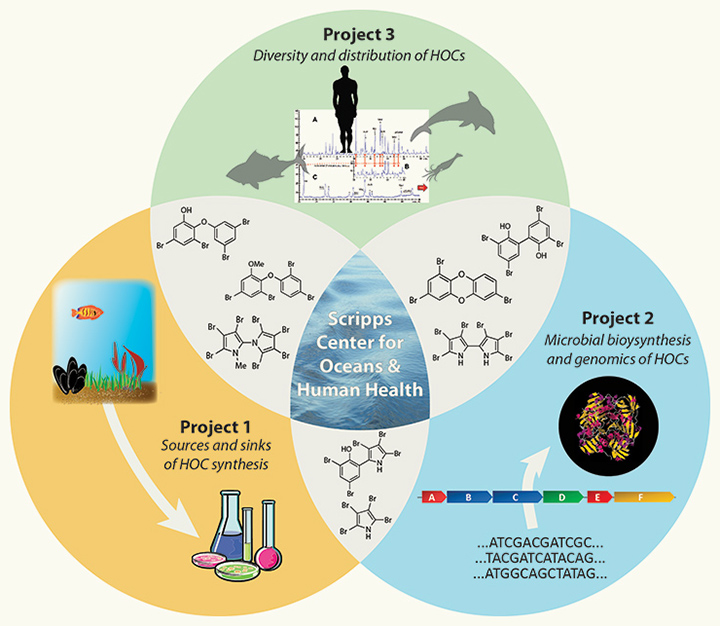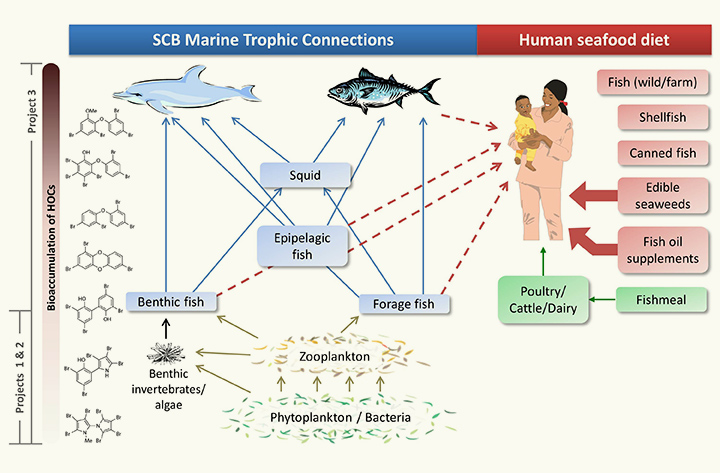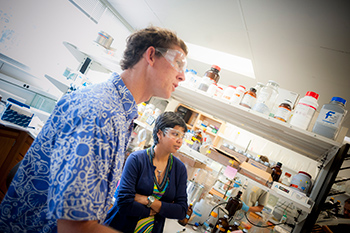New Center Targets Ocean Contaminants and Human Health
Scripps scientists lead two separate projects to track potentially toxic chemicals in marine life and their impacts on human health
By:
- Mario Aguilera
Published Date
By:
- Mario Aguilera
Share This:
Article Content
Capitalizing on UC San Diego’s unique ability to address environmental threats to public health, a new center based at Scripps Institution of Oceanography at UC San Diego will target emerging contaminants found naturally in common seafood dishes as well as man-made chemicals that accumulate in human breast milk.

From left, Paul Jensen, Brad Moore, Eric Allen, Lihini Aluwihare of Scripps and Eunha Hoh of San Diego State University.
With $6 million in joint funding from the National Institutes of Health and the National Science Foundation, the new Scripps Center for Oceans and Human Health will track natural chemicals known as halogenated organic compounds, or HOCs. Human-manufactured varieties include polybrominated diphenyl ethers, or PBDEs, chemicals that until recently were manufactured and broadly used in commercial products as flame retardants in the textile and electronics sectors.
Less is known about the natural versions of HOCs that accumulate in marine mammals such as seals and dolphins and have been identified in top predators that humans consume such as tuna and swordfish. While PBDEs are well known for their toxicity and have been linked to a variety of human diseases, including cancer and thyroid ailments, the origin and transmission of their natural counterparts are poorly understood.
The Scripps Center for Oceans and Human Health will investigate the biology and chemistry behind these natural contaminants in the Southern California Bight, from Point Conception in Santa Barbara south to Ensenada, Mexico.
“The new Center for Oceans and Human Health is uniting leading experts in oceanography and medicine, two areas that make UC San Diego one of the best and most unique universities in the world, to address an emerging threat to public health and safety,” said UC San Diego Chancellor Pradeep K. Khosla. “UC San Diego is proud to be leading this effort in collaboration with other prominent institutions around the San Diego region.”

Click on image for larger view
“The Scripps Center for Oceans and Human Health is focused on addressing to what extent nature contributes to the production and transmission of these toxins in the marine environment,” said Bradley Moore, director of the new center and a professor of oceanography and pharmaceutical sciences at Scripps and the UC San Diego Skaggs School of Pharmacy and Pharmaceutical Sciences. “Southern California waters will be the focus of our study, in part because our state has the highest reported incidence of polybrominated chemicals in human breast milk in the world.”
Scientists have recently become aware that polybrominated compounds appear to enter the marine environment not only as man-made chemicals but also as naturally produced chemicals synthesized by marine microorganisms and algae. Samples from dolphin blubber have revealed hundreds of HOCs that can be separately traced to human and natural sources.
“Humans are susceptible because of the food we consume, like tuna, and there is some evidence that these compounds may be increasing in the coastal ocean due to global change, such as nutrient input from human activity,” said Lihini Aluwihare, a Scripps associate professor of marine chemistry and geochemistry and the new center’s co-director. “The center will focus on biochemical synthesis pathways in tiny microorganisms all the way up through the marine food web to tracing these compounds into humans.”

Click on image for larger view
“Scripps Institution of Oceanography is extremely proud to be the home of the new Scripps Center for Oceans and Human Health,” said Catherine Constable, interim director of Scripps. “After almost 110 years, Scripps continues to expand the scope of its contributions to science and society. Our leadership in marine science extends to matters of public concern, and the environmental contaminants that this new center will be studying provide an excellent example of this kind of work.”
To cover such a wide swath of research, the center will include other local scientists at Scripps’s Center for Marine Biotechnology and Biomedicine, San Diego State University’s Graduate School of Public Health, UC San Diego’s School of Medicine, and the Salk Institute for Biological Studies.
“It’s fascinating and a bit alarming that chemicals related to banned PBDEs are also produced naturally in the environment,” said Moore. “What makes them? And to what extent? While we don’t know the answers to these fundamental questions, our aim is to provide some answers so that we can begin to understand nature’s contribution to these toxic compounds that bioaccumulate in the fish we consume.”
“There is a lot of interest in the potential combined toxicity of the suite of HOCs—natural and man-made—to humans,” said Aluwihare. “People have done tests with individual model compounds, but we really don’t know how they act together.”

Brad Moore and Lihini Aluwihare. Photo by Erik Jepsen/UC San Diego Publications.
In addition to Moore and Aluwihare, the project includes Eric Allen, William Fenical, and Paul Jensen of Scripps; Christina Chambers, Jae Kim, and Michelle Leff of UC San Diego School of Medicine’s Department of Pediatrics; Eunha Hoh, Melbourne Hovell, and Penelope Quintana of San Diego State University; and Joseph Noel of the Salk Institute.
In a separate award on Oceans and Human Health also funded jointly by the National Institutes of Health and the National Science Foundation, Scripps marine biologist Amro Hamdoun will lead a new effort to understand the molecular processes that determine whether marine pollutants will move from the environment into humans and marine animals. The ultimate goal of this work, led by Hamdoun and co-investigator Geoffrey Chang of UC San Diego’s Skaggs School of Pharmacy and Pharmaceutical Sciences and the Department of Pharmacology, School of Medicine, is to determine why some chemicals accumulate in marine organisms, and ultimately in humans, while others do not.
Hamdoun and Chang will be merging cellular studies with biochemical and biophysical studies of an important family of proteins known as “drug transporters.” These proteins act as cellular bouncers, keeping noxious chemicals out of cells. Unfortunately, these same transporters play a crucial role in drug efficacy and retention. They can also be a problem in the treatment of diseases, such as drug-resistant cancers, where they act to keep out the drugs used to kill the cancer cells.
Their collaboration will develop models of transporters from a wide range of organisms that predict how the transporters will work.
“Obviously, having these new structures of marine transporters will enable us to design better pharmaceuticals, but one innovation is that we will apply this to predicting which kinds of toxic industrial chemicals are going to be problems for these cellular bouncers,” said Hamdoun. “This information will be essential for designing safer chemicals that do not accumulate in our bodies.”
“This collaboration is an exciting opportunity to combine and highlight two distinct disciplines at UC San Diego,” said Chang, “synergistically addressing important issues related to marine science and medicine.”
Share This:
Stay in the Know
Keep up with all the latest from UC San Diego. Subscribe to the newsletter today.



